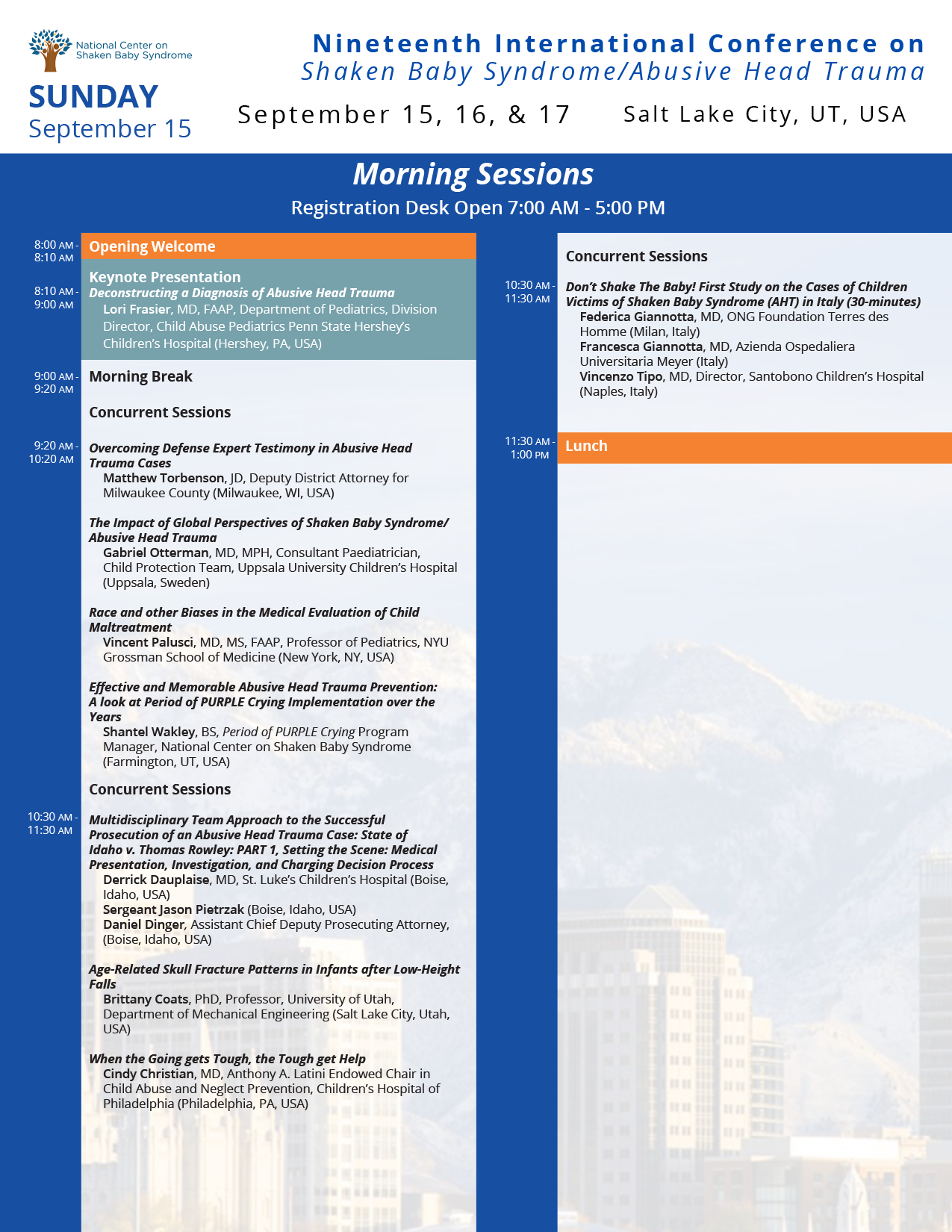Displaying items by tag: aht conference
2024 Salt Lake City
Nineteenth International Conference on Shaken Baby Syndrome / Abusive Head Trauma
Little America Hotel, Salt Lake City, UT
September 15, 16, 17, 2024
The National Center on Shaken Baby Syndrome is pleased to announce our nineteenth biennial conference will be in Salt Lake City on September 15-17, 2024. Nearly 30 years after we hosted our first conference, we will again call Little America Hotel home for 3 days in the gorgeous weather and colors of the Rocky Mountains in the fall.
We are incredibly excited to host in our home state. The hotel underwent an extensive $30 million renovation during COVID, and the property is amazing. Guests will love the free downtown train zone, walkability of the city, vibrant nightlife with bars and endless dining options. The temperatures in the fall are outstanding and you won’t be disappointed with the colorful mountain views from the downtown streets! The room block is now open! Reserve your room using the link in the Venue section below. Conference registration will open in January 2024. We will host a variety of learning opportunities, focusing on those working in the fields of prevention, diagnosis, treatment, investigation, prosecution, or rehabilitation of victims of shaken baby syndrome/abusive head trauma.
Pre-Conference NCSBS x NYC OCME Collaboration: Baby Bootcamp for Trauma Investigators
September 14, 2024 : 9:00A - 12:30P
This symposium will provide invaluable training and information for medical, legal, judicial, and law enforcement professionals on the basics of pediatric trauma investigation. The cost to attend this pre-conference bootcamp is $150 or can be combined as an add-on ticket to the SBS/AHT conference for $125. Register for the bootcamp and conference at the link in the following section.
Conference Loyalty Program
Conference Loyalty Program
Don't forget that if you attended our 2022 International Conference on Shaken Baby Syndrome / Abusive Head Trauma (SBS/AHT) in Philadelphia, you are eligible to receive 10% off the registration fee for our upcoming 2024 conference in Salt Lake City. Our Conference Attendee Loyalty Program introduced at the Philadelphia conference rewards our frequent attendees and places attendees in three tiers*:
- Ally: Earn 10% off registration fees after attending one conference
- Supporter: Earn 15% off after two conferences attended
- Champion: Earn 20% off after three conferences attended
* Attendance credit begins with the 2022 Philadelphia conference.
Email Trachelle at or call 801-447-9360 ext.112 if you have any questions.
2024 Salt Lake City Program
Below is the program for the Nineteenth International Conference on Shaken Baby Syndrome/Abusive Head Trauma as it currently stands. The majority of the program is complete with just a few presentations yet to be confirmed. Schedule is subject to change, so come back often to get the most current program.
Sunday, September 15, 2024
Monday, September 16, 2024
Tuesday, September 17, 2024
Exhibitor Information
For any organizations or persons interested in registering an exhibit booth at the Nineteenth International Conference on Shaken Baby Syndrome / Abusive Head Trauma, information on fees, set-up and registration is below.
Exhibit Fees
The rate to exhibit at the conference is $500 for organizations and $250 for nonprofit organizations. This fee can be processed via credit card or check. All payment must be received prior to the conference. This exhibit fee does not include registration to the conference. If interested in attending the keynote presentations, breakout session and access to the breaks, you can register in the above Registration Section.
Exhibit Set-Up
A standard exhibit space includes the following amenities:
- 1 6’ draped table
- 1 electrical outlet (upon request only)
- 2 chairs
Registration
To register, download the Exhibitor Application form, fill out the requested information and return completed form to or mail to:
National Center on Shaken Baby Syndrome
Attn: Trachelle Hilton-King
1433 N 1075 W
Suite 110
Farmington, UT 84025
Registration
-
Registration is OPEN!
2024 Registration Prices
Physicians $595 General $495 Students* $250 Families of Victims $250 Survivors Free Groups of 5-9** $425 per
attendeeGroups of 10+* $375 per
attendeeBaby Bootcamp for Trauma
Investigators Only$150 per
attendeeBaby Bootcamp for Trauma
Investigators Add-On$125 per
attendee*Will need a field of study/year and affiliation to register
**Will need to register together and pay on a single transactionRegistration rates include access to all keynote, breakout sessions and opening reception. The NCSBS will provide two breaks per day which includes coffee and snack items. Lunch is on your own.
Be advised: Clicking the "REGISTER NOW" button will take you to our conference micro-site. This micro-site is associated with our conference app, Zoho Backstage for Attendees. This website, the app and the micro-site will be updated regularly as we gather more information. You can go to the micro-site directly at: https://ncsbsconference.zohobackstage.com/2024slc
If you have any questions pertaining to registration, please contact Trachelle Hilton-King at or (801) 447-9360. ext. 112.
Salt Lake City Venue
-
The Little America Hotel
500 Main Street
Salt Lake City, UT 84101
The Little America Hotel underwent an extensive $30 million renovation during COVID, and the property is amazing. Guests will love the free downtown train zone, walkability of the city, vibrant nightlife with bars and endless dining options. The temperatures in the fall are outstanding and you won’t be disappointed with the colorful mountain views from the downtown streets!
The NCSBS has secured a fantastic group rate of $219++ a night (excluding taxes) for conference attendees. Rates are dependent on room block availability. Dates available from September 9th - 24th for any who are looking to extend their stay. Extended stay availability is based off hotel occupancy.
Salt Lake City Program
-
Below is the program for the Nineteenth International Conference on Shaken Baby Syndrome/Abusive Head Trauma as it currently stands. The majority of the program is complete with just a few presentations yet to be confirmed. Schedule is subject to change, so come back often to get the most current program.
Sunday, September 15, 2024
Monday, September 16, 2024
Tuesday, September 17, 2024
Exhibitor Information
-
For any organizations or persons interested in registering an exhibit booth at the Nineteenth International Conference on Shaken Baby Syndrome / Abusive Head Trauma, information on fees, set-up and registration is below.
Exhibit Fees
The rate to exhibit at the conference is $500 for organizations and $250 for nonprofit organizations. This fee can be processed via credit card or check. All payment must be received prior to the conference. This exhibit fee does not include registration to the conference. If interested in attending the keynote presentations, breakout session and access to the breaks, you can register in the above Registration Section.
Exhibit Set-Up
A standard exhibit space includes the following amenities:
- 1 6’ draped table
- 1 electrical outlet (upon request only)
- 2 chairs
Registration
To register, download the Exhibitor Application form, fill out the requested information and return completed form to or mail to:
National Center on Shaken Baby Syndrome
Attn: Trachelle Hilton-King
1433 N 1075 W
Suite 110
Farmington, UT 84025
Conference Loyalty Program
-
Conference Loyalty Program
Don't forget that if you attended our 2022 International Conference on Shaken Baby Syndrome / Abusive Head Trauma (SBS/AHT) in Philadelphia, you are eligible to receive 10% off the registration fee for our upcoming 2024 conference in Salt Lake City. Our Conference Attendee Loyalty Program introduced at the Philadelphia conference rewards our frequent attendees and places attendees in three tiers*:
- Ally: Earn 10% off registration fees after attending one conference
- Supporter: Earn 15% off after two conferences attended
- Champion: Earn 20% off after three conferences attended
* Attendance credit begins with the 2022 Philadelphia conference.
Email Trachelle at or call 801-447-9360 ext.112 if you have any questions.













Donate